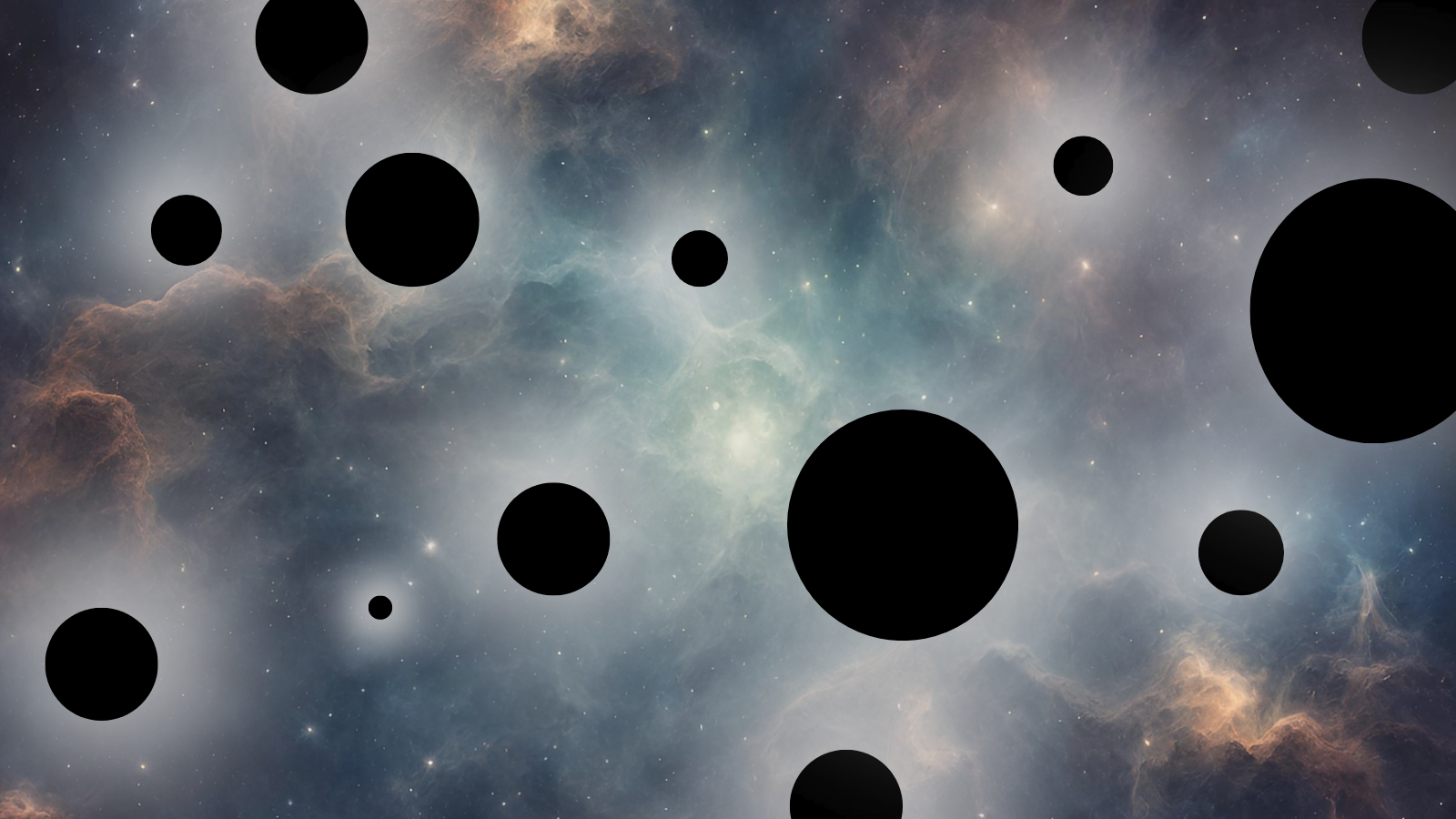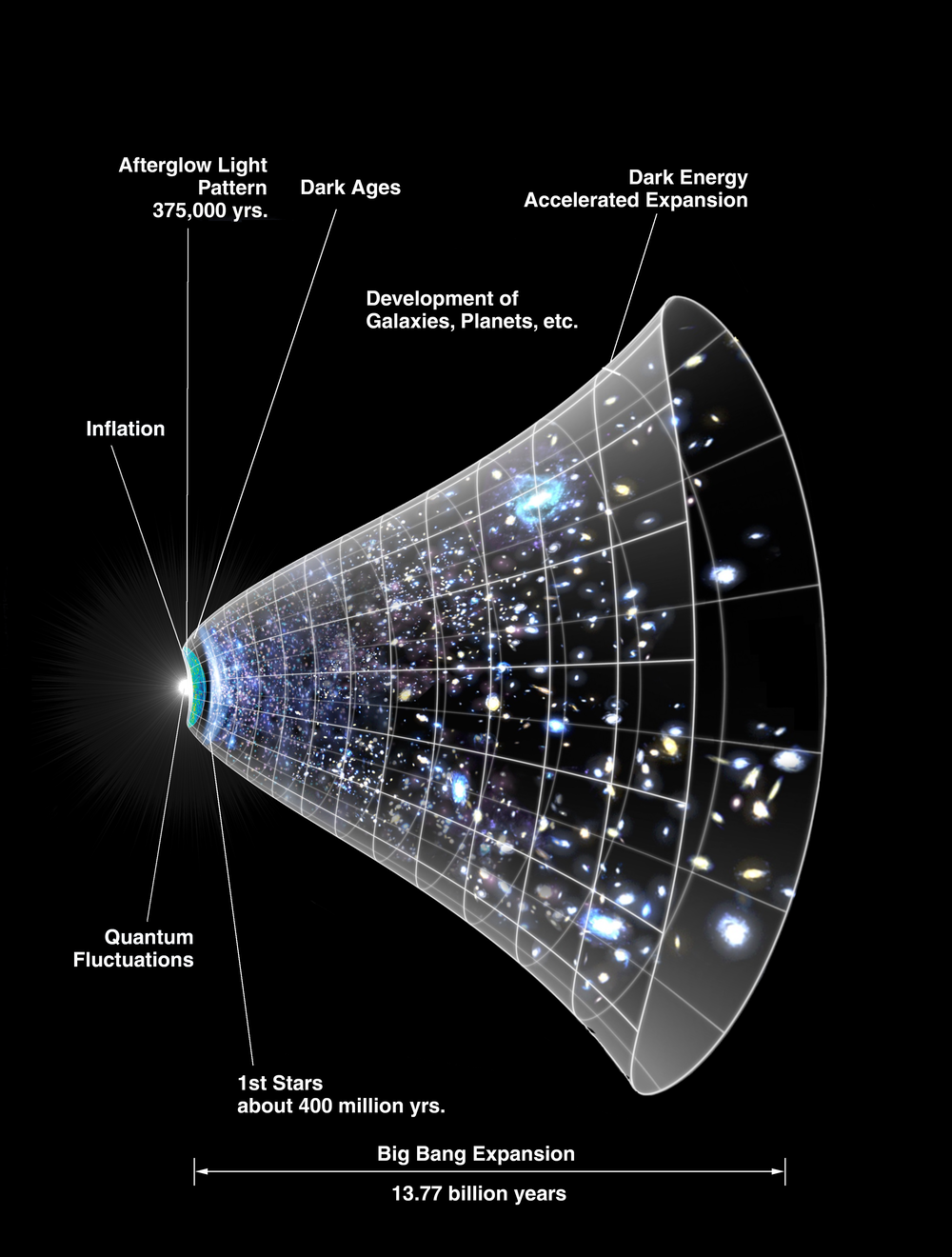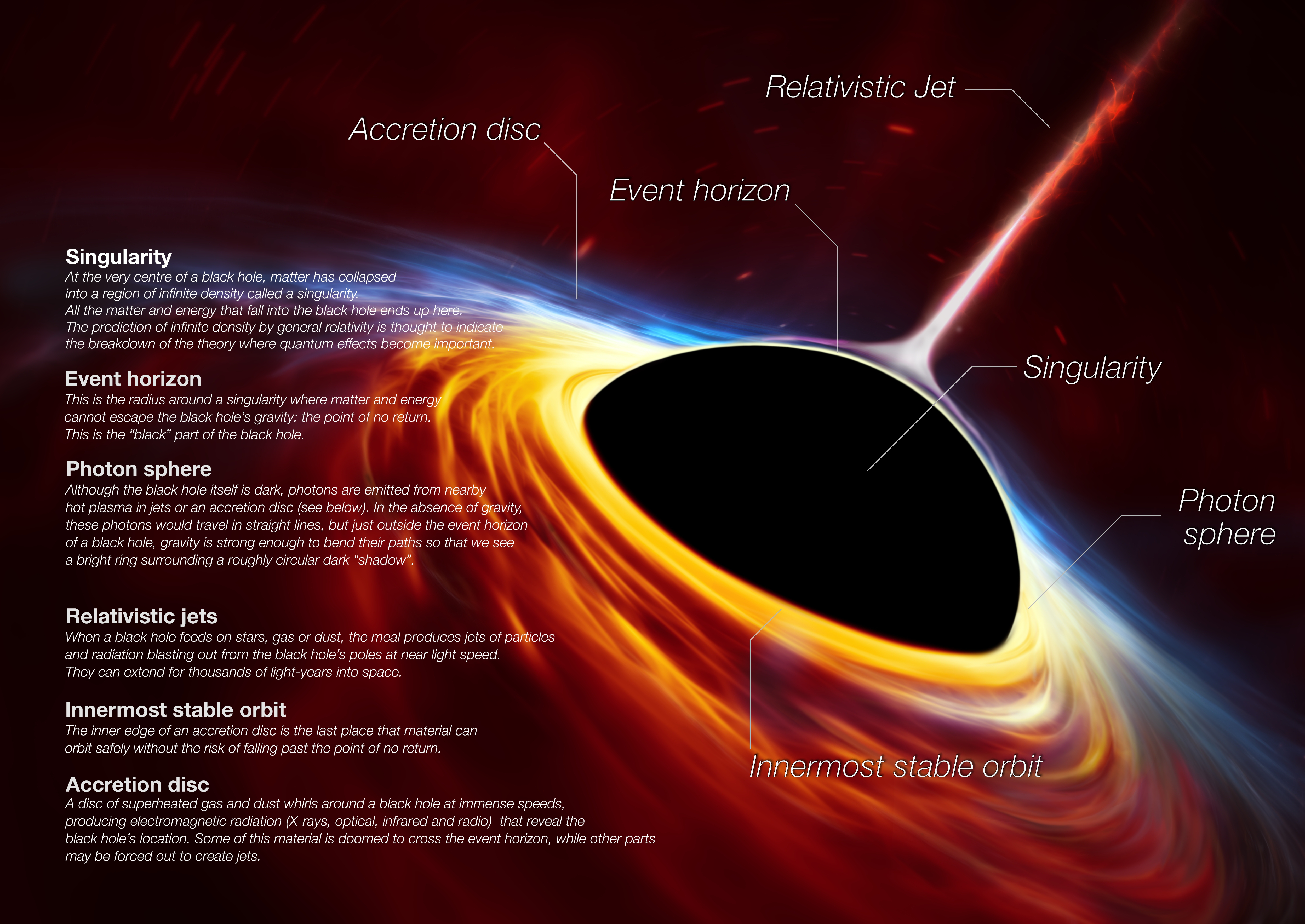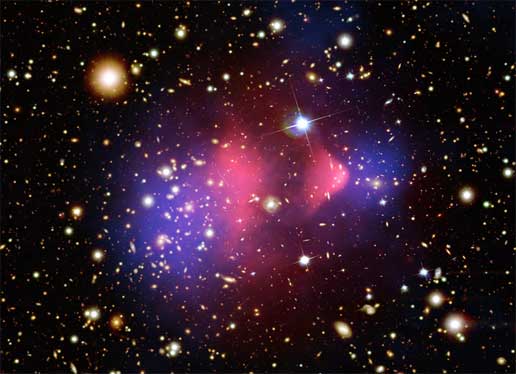Tiny black holes left over from the Big Bang may be prime dark matter suspects
"I wouldn't say primordial black holes were ever dismissed as dark matter candidates; they were ignored for a while though."

When it comes to primordial black holes being dark matter suspects, their alibi may be falling apart. Tiny black holes, created seconds after the birth of the universe, may survive longer than expected, reigniting a suspicion that primordial black holes could account for dark matter, the universe's most mysterious stuff.
Dark matter currently represents one of the most pressing problems in physics. That is because, despite making up an estimated 85% of the matter in the cosmos, dark matter remains effectively invisible to our eyes because it doesn't interact with light.
Because the particles that comprise atoms that compose "everyday" stuff we can see, like stars, planets, and our own bodies, clearly do interact with light, this has prompted the search for dark matter particles outside the Standard Model of particle physics. Many scientists believe the answer could still lie within the Standard Model, however, if we consider a diminutive cousin of cosmic objects we usually view as tremendously massive, and even monstrous: Black holes.
Max Planck Institute scientists Valentin Thoss and Ana Alexandre are two researchers who have recently been involved in such studies. They posit tiny black holes born over 13.8 billion years ago, just after the Big Bang, that are no larger than a proton, could cluster to become suspects for dark matter without the need for new physics.
Not only has a recent change in thinking regarding how black holes "evaporate" prompted a reassessment of primordial black holes' viability as dark matter suspects, but as the search for a dark matter particle continues to mostly draw a blank, more researchers could begin to look at the primordial black hole dark matter theory more seriously.
What are primordial black holes?
"As the name suggests, 'primordial black holes' are a type of black hole that is formed at the beginning of the universe," Thoss told Space.com. "Within the first fraction of a second of the universe, in fact."
Get the Space.com Newsletter
Breaking space news, the latest updates on rocket launches, skywatching events and more!
He explained that all the structures we observe in the universe, from superclusters of galaxies to the galaxies within themselves, are formed from slight overdensities in space present during the early universe. If the early universe experienced much stronger density fluctuations than the those which created these features, and these fluctuations collapsed at an earlier time than galaxies indeed formed, then those overly dense patches could have spurred primordial black holes.
Thoss added that, depending on the time at which this collapse may have happened as well as the scale of the collapse, these primordial black holes would have very different masses. The primordial black holes that Thoss and Alexandre considered possible dark matter candidates would have masses ranging between a few tons and a thousand tons, to be specific, which is less than the mass of a planet and more in the category of a small asteroid.

Considering how the smallest black holes scientists have discovered to date, known as stellar-mass black holes, have masses equivalent to between 3 and 50 times that of the sun — which itself is 2.2 times 10 to the power of 27 (22 followed by 26 zeroes) tons — these primordial black holes are incredibly tiny.
Like their larger black hole counterparts formed from either the collapse of massive stars or the merger of relatively smaller black holes, according to Alexandre, primordial black holes would have a light-trapping outer boundary called an event horizon. The diameter of this horizon is determined by the mass of the black hole, which means the event horizon would be incredibly small in those cases. "Smaller than the radius of a proton," Alexandre said.

Small, primordial black holes had previously been ruled out as dark matter candidates because all black holes are thought to "leak" a type of thermal radiation first theorized by Stephen Hawking in 1974 and later named "Hawking radiation."
The smaller a black hole, the more rapidly it should leak Hawking radiation and, thus, the faster it should evaporate. That means if primordial black holes ever existed, the smallest examples shouldn't be around today — yet, dark matter clearly is.
"Primordial black holes with the masses Ana and I are now considering had been essentially previously considered ruled out because they were assumed to have evaporated fully by this time in the universe," Thoss said.
Recent work by Giorgi Dvali, a theoretical physicist at the University of Munich who has collaborated with Thoss and Alexandre, has suggested that the evaporation process breaks down at a certain point, however. This means primordial black holes of the masses the scientists considered could achieve a semi-stable state.
"In order to decrease its mass through the emission of Hawking radiation, the black hole has to 'rewrite' its information, or something else. This rewriting process takes time," Alexandre explained. "It is called 'memory burden' because of this memory that now has to be passed along to something else, and that just kind of slows down the evaporation process overall. So it's a kind of stabilization."
And that "rescue mechanism" means primordial black holes are back as potentially dark matter candidates!
A dead ringer for dark matter?
The fact that primordial black holes could exist in the universe today, however, doesn't immediately mean they should be considered dark matter suspects. As it happens, there are other reasons to link these tiny hypothetical black holes to the universe's mysterious matter content.
Perhaps the most obvious connection is dark matter's lack of interaction with light. Dark matter doesn't emit or reflect light, and the event horizon that bounds all black holes represents the point at which the escape velocity necessary to cross it exceeds the speed of light. That means primordial black holes would "trap" all incident light, resulting in an apparent lack of interactions.
"If they are light enough, somewhere around a planetary mass, primordial black holes behave like particles of dark matter for all purposes that we are interested in," Thoss said. "Dark matter is 'collision-less' in standard models, so dark matter particles do not interact with each other to such a degree that it affects the universe."
He added that if primordial black holes are lighter than planetary masses, then, even on cosmic timescales, they would be so small they'd very rarely collide. These primordial black holes could rather cluster to create the gravitational effects we currently attribute to dark matter, such as providing the gravitational influence that prevents rapidly spinning galaxies from flying apart.

Yet, if primordial black holes have to cluster to account for the effects of dark matter, what would prevent these black holes from drawing together and merging to create larger black holes? Wouldn't a cluster of tiny black holes eventually just become one tremendous black hole? Thoss said this has been investigated, and the answer is simply: "No."
"Even if you take into account clustering, the time scales for the merger are so long that they would only merge into really massive black holes over the entire age of the universe," he continued.
Thoss added that the beauty of using primordial black holes as an explanation for dark matter is that, unlike suggesting a hypothetical particle such as an axion to explain the mystery, primordial black holes don't require an extension to the Standard Model of particle physics, the best explanation we have of the universe on subatomic scales.
Still, primordial black holes are going to be incredibly difficult to confirm as dark matter, if they really do explain the phenomenon. Again, their light-trapping nature means they are effectively invisible. Plus, at such diminutive sizes, they don't have the same immense gravitational effects as their stellar and supermassive brethren.
Even then, should a cluster of primordial black holes be detected, there is no real way to tell the difference between lots of little black holes and one large black hole.
Despite this difficulty, Thoss and Alexandre intend to stay hot on the tail of primordial black holes — theoretically, at least. If particle candidates for dark matter continue to fail to manifest, perhaps the answer is to get more physicists to start looking over the metaphorical fence between particle physics and cosmology.
"I wouldn't say that primordial black holes were ever dismissed as dark matter candidates; they were ignored for a while though," Alexandre said. "Now, lined up with the fact that we don't really have any detection of particle dark matter, I think it just becomes more and more relevant to consider this option."
Join our Space Forums to keep talking space on the latest missions, night sky and more! And if you have a news tip, correction or comment, let us know at: community@space.com.

Robert Lea is a science journalist in the U.K. whose articles have been published in Physics World, New Scientist, Astronomy Magazine, All About Space, Newsweek and ZME Science. He also writes about science communication for Elsevier and the European Journal of Physics. Rob holds a bachelor of science degree in physics and astronomy from the U.K.’s Open University. Follow him on Twitter @sciencef1rst.
-
Questioner Gravity would come into play and small or microscopic black holes would be strongly inclined to merge (clump).Reply
If they all had the same electric polarity (or something akin to it) they might avoid merging with one another,
but it wouldn't stop regular matter from falling into (merging with) them.
DM is a hypothesis for mass with an as yet unidentified source.
I say it is a secondary/additional mass curve coming from identifiable BHs. It is a thin, flat mass curve that extends extremely far the source BH.
That's why it hasn't already been connected to BHs.
That would explain why there is a tight correlation between the size of galactic central black holes and the hypothesized quantity of DM in their respective galaxies.
I think anywhere there is a clump/cloud/halo attributed to DM a BH will be found at its center. -
danR Reply...the black hole has to 'rewrite' its information, or something else. This rewriting process takes time," Fernandes Alexandre explained. "It is called 'memory burden' because of this memory that now has to be passed along to something else, and that just kind of slows down the evaporation process overall. So it's a kind of stabilization."
That is kind of the worst 'explanation' of any theoretical attribute I have ever kind of seen in a scientific exposition, or something else. Normally when I see something like that, I'm expecting it is a loose sketch for a more rigorous elaboration. Nothing followed. When a theoretician is essentially claiming that Hawking was dead wrong about the tail process of BH evaporation, he better be good, or the popular-article writer better extract it from him.
'You don't know your own stuff unless you can explain it to a bartender", to paraphrase the old physics saying. -
billslugg I interpreted it as: The BH contains information, which cannot go away, thus towards the end it has all this information condensed into such a tiny volume it has to stop evaporating.Reply -
orsobubu When i want to put me in a good mood and have a laugh, i often find nothing better than reading some bizarre theory on dark matter and the standard model; after reading this article I am really satisfied, it is really fun to watch the intellectual somersaults that certain scientists are capable of doing in order to publish something, get fundings, get interviewed and keep their job, manipulating a mathematical model as disastrous as hilbert's false interpretation of the already problematic schwarzschild and droste field equationsReply -
Questioner Information is insight based on an organization of some select/filtered data. The rest of infinite data is irrelevant and easily understood as noise or anti-information.Reply
Insight is a tool of a mind. Insight is not existential.
Information/insight is of necessity local/finite.
Further Godel proved the universe can not be closed because it has a self referencing element,
namely us. -
Unclear Engineer I have 2 problems with this hypothesis.Reply
The first is that I do not accept as fact that "information" has physical presence and cannot be destroyed. So I doubt the idea that "information" would stop the "evaporation" of black holes in order to be preserved. I am not even convinced that Hawkings got the evaporation thing right in the first place. I have never heard a "bartender level" explanation that didn't seem to have severe conceptual flaws. So, I am willing to believe that black holes might not evaporate at all and tiny primordial ones might still exist.
But, if they do exist in such hugely large numbers that they can make up 5.7 times the amount of mass that we can detect, why aren't these tiny black holes colliding with larger, visible pieces of baryonic matter like asteroids, planets. stars, etc? and sucking in their mass, presumably with some emission of light from outside their event horizons as the matter gets compressed, heated and ionized on the way in? It seems like that should be happening in an observable way with an observable frequency, considering the current level of telescopic astronomy observations currently being conducted. -
billslugg The amount of matter in the universe is very small. The vast majority of Black Holes might simply have nothing to draw inward.Reply
If the Sun was a golf ball, the nearest star would be another golf ball 600 miles away. The chances of them ever colliding are very small. -
Unclear Engineer Bill, That example is only 2 golf balls. Try it with enough black hole particles to make 5.7 times the mass we can see out of particles that are each "smaller than a proton". Those tiny back holes should be practically everywhere. And, they would be attracted to the visible matter, so it would not even be just a random encounter for one to collide with a star or smaller body.Reply
Looking at the number of impacts on the Moon evidenced by the craters, and the fact that we have even seen impacts occur while we were watching with telescopes, it is hard to believe that there could be 5.7 times as much matter in the form of tiny black holes flying around and none of them hit the moon over the last 4.6 billion years.
So, unless this theory includes some (unreported) mechanism that prevents these tiny black holes from sucking in visible matter, I think it is still a non-starter for being the "dark matter" we need to make astronomy observations fit known physics. -
Unclear Engineer Ok, let's look at it this way:Reply
The radius of a black hole's event horizon depends on its mass, so we can calculate the mass of a black hole the diameter of a proton. The diameter of the proton is estimated at about 10^-15 meters.
The Schwarzschild radius is given as r = 2GM/c^2.
So, solving for the mass of a black hole with a proton diameter event horizon gives:
(10^-15m) x (3 x 10^8 m/s)^2 / (2 x 6.67 x10^-11 m^3/(kg x s^2) = 0.675 x 10^-10 kg
The mass of our solar system is about 10^30 Kg. So, the mass of the black holes making up (85% /15% =) 5.67 times that amount of mass would be 5.67 x 10^30 kg / 0.675 x 10^-10 kg = 8.4 x 10^40 tiny black holes.
Assuming the solar system accounts for all of the mass within something like 3 light years, that volume would be 4/3 x 3.1416 x (3 x 9.46 x 10^15 meters)^3 = 1.06 x 10^49 cubic meters.
So, for a rough average, I think of 1.06 x 10^49 / 8.4 x 10^40 = 1.26 x 10^8 cubic meters of space per tiny black hole.
Considering that the Sun's volume is about 1.4 x 10^27 cubic meters, there should be something like 1.4 x 10^27 / 8.4 x 10^8 = 1.7 x 10^20 of these tiny black holes already in our Sun.
Even the Moon, with a volume of 2.2 x 10^19 cubic meters, should have roughly 2.2 x 10^19 / 1.26 x 10^8 = 1.75 x 10^11 of these tiny black holes already inside of it.
People can check my math, but, unless I have made a colossal math error, it seems like there would need to be some high frequency of these tiny black holes hitting observable objects if they were numerous enough to account for the amount of "dark matter" that the theory needs.
Or, there needs to be some physical mechanism that makes it impossible for such tiny black holes to be capable of sucking in baryonic matter. -
billslugg But then the question becomes: What happens when a proton sized BH hits the Earth? Would we expect an explosion? Maybe it just passes right through. I'll look it up.Reply
EDIT: The question has been answered on quora. It depends on the size of the black hole and how fast it is going. Primordial black holes are less than an atom in size and would transit the Earth leaving a trail of radiation damage in the rock and depositing a stick of dynamite worth of energy, but along the entire path. One paper estimates two primordial black holes pass through Earth every day.
https://physics.stackexchange.com/questions/568743/what-would-happen-if-a-miniature-black-hole-or-a-pbh-would-pass-through-earth#:~:text=Because%20of%20the%20relativistic%20speed%2C%20the%20%28stress%29%20energy,interaction%29%2C%20or%20it%20would%20destroy%20it%20%28enormous%20stress-energy%29.









